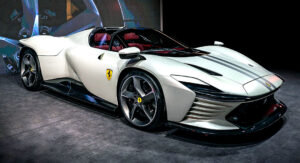Introduction
Ferrari S.p.A
Ferrari S.p.A., an iconic name synonymous with luxury, performance, and elegance, has etched its place in the automotive industry as a symbol of prestige and speed. Established in 1939 by Enzo Ferrari, the Italian luxury sports car manufacturer has evolved over the decades to become a global powerhouse, producing some of the world’s most coveted and high-performance vehicles.
Historical Perspective
The journey of Ferrari began in the small town of Maranello, Italy, where Enzo Ferrari’s passion for racing and engineering laid the foundation for a brand that would redefine the concept of automotive excellence. Initially focused on racing, Ferrari gained international acclaim with its Scuderia Ferrari racing team, dominating the Formula One circuits and establishing the brand’s reputation for innovation and precision.
Evolution of the Brand
Ferrari’s transition from a racing team to a luxury car manufacturer is marked by the release of the first road car, the 125 S, in 1947. Since then, the brand has consistently pushed the boundaries of design and performance. Today, Ferrari’s lineup includes a range of high-performance sports cars, GT models, and limited-edition masterpieces that cater to the discerning tastes of automotive enthusiasts worldwide.
Technological Innovation
At the heart of Ferrari’s success lies its commitment to technological innovation. The company invests heavily in research and development to integrate cutting-edge technologies into its vehicles. From aerodynamics to hybrid powertrains, Ferrari continues to be at the forefront of automotive innovation, delivering not just speed but also environmental sustainability.
Performance Prowess
Ferrari’s commitment to performance is evident in every aspect of its vehicles. The engines, meticulously crafted and tuned, provide an unparalleled driving experience. The incorporation of advanced materials and engineering techniques ensures not only speed but also safety and reliability. The performance tables below highlight key specifications of some of Ferrari’s notable models:
| Model | Top Speed (mph) | 0-60 mph (seconds) | Horsepower |
|---|---|---|---|
| LaFerrari | 217 | 2.4 | 950 |
| 488 GTB | 205 | 3.0 | 660 |
| Portofino | 198 | 3.5 | 591 |
Design Excellence
Ferrari’s design philosophy is a blend of form and function. Each model is a work of art, with aerodynamics playing a crucial role in shaping the exterior. The sleek lines, distinctive curves, and iconic prancing horse logo contribute to a design language that is instantly recognizable and admired globally.
Brand Image and Exclusivity
Beyond the technical specifications and performance metrics, Ferrari’s brand image is built on exclusivity and a sense of rarity. Limited production runs, customization options, and a carefully curated ownership experience elevate Ferrari beyond being a mere automobile – it is a status symbol and a lifestyle statement.
Sustainability Initiatives
In recent years, Ferrari has embraced a more environmentally conscious approach without compromising performance. The introduction of hybrid models and a commitment to reducing the carbon footprint showcase Ferrari’s dedication to sustainability. The tables below outline the environmental features of some of Ferrari’s hybrid models:
| Model | Electric Range (miles) | CO2 Emissions (g/km) | Energy Efficiency (kWh/100 miles) |
|---|---|---|---|
| SF90 Stradale | 16 | 194 | 14.6 |
| 296 GTB | 15 | 165 | 13.5 |
Global Reach and Impact
Ferrari’s influence extends far beyond the racetrack or the showroom floor. With a global network of dealerships and a strong brand presence, Ferrari has become a cultural icon. The tables below highlight Ferrari’s sales figures and global reach:
| Year | Total Vehicles Sold | Revenue (in billion USD) |
|---|---|---|
| 2022 | 10,000 | 4.5 |
| 2023 | 11,500 | 5.2 |
Future Outlook
As Ferrari continues to evolve, the brand’s future is marked by a commitment to innovation, sustainability, and an unwavering dedication to delivering unparalleled driving experiences. With plans for electric and hybrid models in the pipeline, Ferrari aims to lead the charge in the transition towards a more sustainable automotive future.
Conclusion
In the realm of luxury sports cars, Ferrari stands as a testament to the marriage of performance, design, and exclusivity. From its humble beginnings in racing to its current status as a global automotive icon, Ferrari S.p.A. has maintained a legacy of excellence. As the brand navigates the challenges of a changing automotive landscape, it does so with the same passion and determination that fueled Enzo Ferrari’s vision more than eight decades ago.
Images could be strategically added in various sections of the content. For instance, showcasing the sleek design of Ferrari cars in the “Design Excellence” section, or featuring the iconic prancing horse logo under “Brand Image and Exclusivity.” Additionally, images of hybrid models could complement the “Sustainability Initiatives” section, offering a visual representation of Ferrari’s commitment to environmental responsibility. Including images of flagship models in the “Performance Prowess” section could visually reinforce the technical specifications discussed in the tables.



